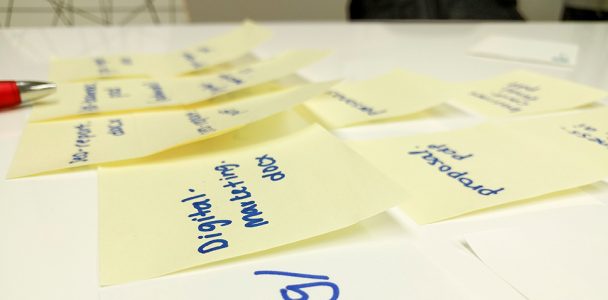Posted on May 5, 2016 at 11:05 am
What is Card Sorting?
Card sorting is an inexpensive and scientific method used by information architects and user experience designers to determine the organizational structure of websites and other projects.
When executed properly, card sorting can help sort large quantities of information into its most logical and intuitive categories and even help to define navigation menu items.
What Makes Card Sorting So Effective?
When it comes to creating websites, usability is everything. Card sorting is brilliant precisely because it is done for users, by users. By observing how users intuitively group information, we can build a site that focuses on their needs from the ground up. This makes navigation as easy and intuitive for the user as possible.
The goal of any card sort is to improve the labelling, grouping and organization of information. Organization that mirrors the mental processes of the user is going to be easy for the user to navigate.
Why is User-Centred Design Important?
Many companies have wonderful products, services and rich content to share with their customers. However, if their online presence is poorly organized and difficult to navigate, there will be a barrier to user engagement that can be extremely costly in terms of lost conversions. Consumers are very impatient, especially online. If your competition’s website offers a more efficient interface for shopping and viewing product information, frustrated users will migrate there and take their attention, loyalty and credit cards with them. If your website is organized in a user-centric manner, visitors will exhibit more site engagement, lower bounce rates and more conversions and completed calls to action.
How is Card Sorting Executed?
Firstly, the developer or information architect must compile a list of content that will be sorted by the participants. This is usually done on a spreadsheet. Next, all the content items are each written on their own card with a marker. 30-70 cards has been found to be the most effective range. Participants are then asked to organize the cards into groups. Card sorting can be done in either an open or closed format.
Open Format
In an open card sort, participants have more freedom. They may organize the cards given to them into groups that make sense to them. There are no wrong answers. They are then asked to come up with parent names for these groups. Blank cards and a marker are supplied so that participants can add their own list items or rename existing ones. This open format works well when the developer has yet to figure out the best system for organization. The more users overlap on one preferred method of organization, the more likely that method is the most intuitive one.
Closed Format
In closed card sorting, the parent categories are fixed because the sitemap and navigation menu have already been created. Participants are asked to place new content items within the existing structure. This process sheds light on how users want to sort new information within a pre-existing project.
Card Sorting Should Answer These Questions:
- How do the users tend to organize the content? By subject? date? taxonomy?
- How many parent categories are there?
- What are the names of the parent categories?
- What items did they struggle to categorize?
- What items seem to fit in more than one category?
- How do different types of users tend to group information?
Based on the trends exhibited by the users, the developer can begin to create wireframes which depict how the content of the site will be organized. The parent categories named by the card sorters will become the clickable navigation links that visitors will use to move about the site. This is why information architecture should always come before site construction.
Other Uses for Card Sorting?
Card sorting is used frequently by information architects and user experience designers, but it can also be used in virtually any situation. Ultimately, the goal of any card sort is to improve the labelling, grouping and organization of information.
Here are some ways your organization can potentially use card sorting:
- Assignment of roles & responsibilities
- Organization and/or location of office tools, supplies, and stationery
- Grouping of products for retail shelf space allocation
Our Experience
Our team at Unique Web Development recently used card sorting to determine the best file structure for our site resources. After working together in a group, we created a much cleaner, more intuitive structure that we have since adopted and now use in all of our projects. The process was fast, collaborative and great for team building. We improved our efficiency and observed just how versatile the process can be.
How Can We Help You with Your Project?
There is more to creating an online presence than just having a website up. To be successful, you must have a clear idea of who your users are and what makes them tick. At Unique Web Development, on average, we dedicate 40% of every project to research, planning and strategy. This involves creating user personas, analyzing your competition and implementing user-centric testing, such as card sorting, to ensure that when your site is up, it is as user-friendly and efficient as possible. This will maximize user engagement and conversions, producing a greater return on your investment. The success of your online presence should rest in the hands of experienced professionals. Contact us and let’s begin working on something great together!


